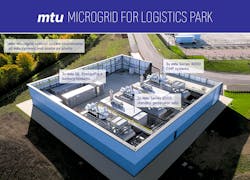Using a microgrid as an energy supply promises numerous advantages to businesses of all types. They not only gain a reliable source of power that provides capacity on top of the public grid, thus rendering them independent of it in uncertain times, but they can also positively influence their CO2 emissions by integrating renewables in their microgrid configuration.
But determining which configuration offers the most efficient, ecological and cost-effective solution for each user depends on multiple factors. The type and form of energy needed as well as the location of the microgrid and the condition of the local public grid are all important to consider in the configuration. Additionally, the degree of flexibility and modularity needed, not only for a stable energy supply but to accommodate future technological developments for further cost savings and CO2 reductions, is essential to designing a microgrid that will be able to meet the demands of today and tomorrow.
A tale of two microgrids
The uniqueness of every microgrid is best illustrated by looking at two projects by Rolls-Royce Power Systems: one at the Tritax Symmetry Logistics Park in Biggleswade, U.K., and the second at a Proquinal textile manufacturing site in Costa Rica.
At the Tritax Symmetry Logistics Park, the focus was on creating sustainable, stable energy supply for a new 2-MW energy center where the existing grid capacity was not sufficient to meet its needs. After a thorough assessment of the site, its needs and its required uptime, an integrated microgrid solution was created featuring photovoltaics, three mtu Series 4000 combined heat and power (CHP) plants, two mtu EnergyPack battery storage containers and two mtu Series 2000 standby generators for additional redundancy. The two battery energy storage systems with 2.3 MWh stored electrical energy capacity enable the system to respond quickly and without CO2 emissions to fluctuating load demands. In times of low demand, the battery storage systems serve as the sole power source.
Each component asset in the microgrid is controlled by a central smart microgrid control system. Connected through a fiber-optic communication network, the controller identifies load requirements, calculates the most efficient distribution of power and deploys sufficient assets while keeping enough power in reserve to provide electricity even in the event of utility grid or asset failure. This strategy not only provides a power supply that is reliable, stable and environmentally friendly, but the operators can also expect a 5%-10% decrease in energy costs.
For the Proquinal site in Costa Rica, Rolls-Royce adopted an entirely different approach with a solution that does not tap into the public grid at all during high-tariff peak times. After a thorough review of the site, an integrated mtu microgrid system was installed consisting of two battery storage systems, solar panels and smart controls, allowing the entire plant to be completely disconnected from the public grid for five hours each day. During that time, the plant is fed by the battery systems, each offering an output of 750 kVA and a storage capacity of 2.1 MWh. As in the U.K. example, an mtu smart control system regulates the microgrid automatically, optimizing the energy flow to ensure reliability. This configuration results in savings of approximately $415,000 per year and enables a reduction in CO2 emissions by 285 tons annually.
Flexible and future-proof – the power of microgrids
When assessing the potential of a microgrid solution, the importance of the planning stage and finding the most efficient energy mix for the given application cannot be overstated. Considering the unique needs of each project along with the various site conditions and constraints will ultimately yield the most effective microgrid configuration. Essential to achieving the full potential of the microgrid is the integration of a smart control system to ensure that each asset is leveraged to provide its optimal energy output. When planned with clear objectives and the necessary input requirements, microgrids present an attractive opportunity for many industrial and commercial customers on their path toward a future-ready, climate-friendly power supply.










